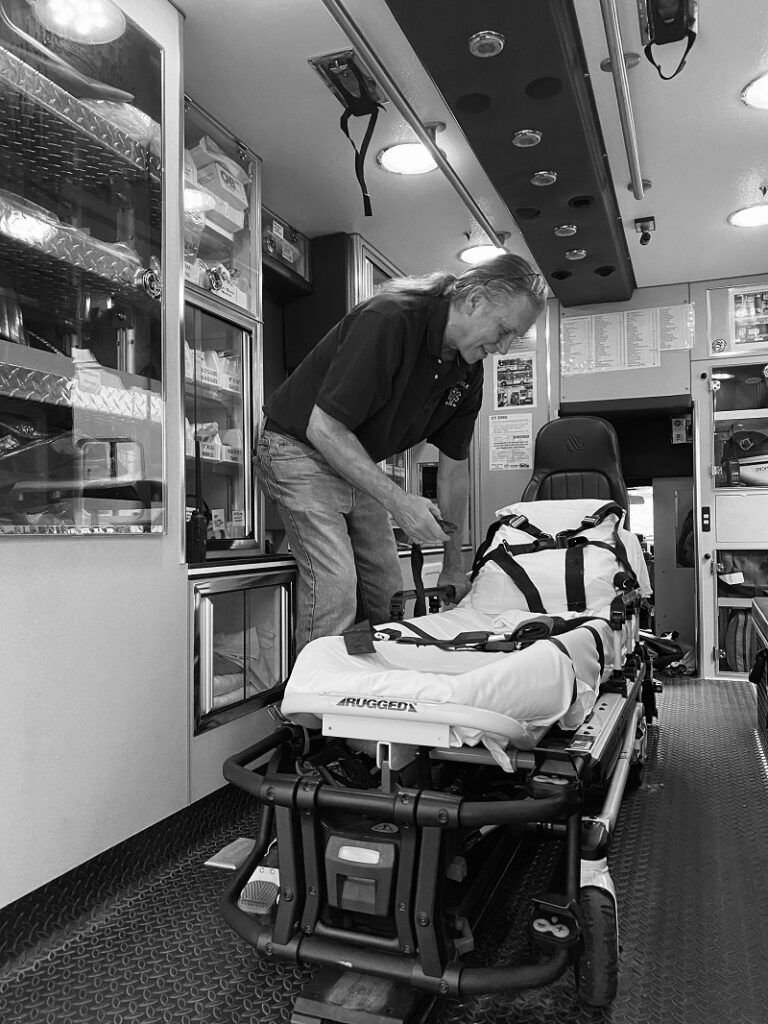Ambulance Awareness: Volunteers Needed
What does it take for them to always be there?
by Jude Mead

Nineteen years ago, Jon Riedeman moved to Norfolk and was attending a local venue when his friend collapsed to the floor. He had had a cardiac arrest. A bystander who was a member of the ambulance began CPR immediately. Then 911 was called and within minutes more members of the volunteer ambulance service arrived. One member was just around the corner; he ran in with the defibrillator that he carries in his truck. This is a device that restores a normal heartbeat by sending an electric pulse to the heart. They applied this life saving shock to Jon’s friend and saved his life.
The ambulance transported the patient to Winsted where they rendezvoused with Lifestar and he was flown to Hartford Hospital. “The volunteer’s response time was incredibly quick. Up until that moment I didn’t think about the importance of the ambulance and I didn’t even know there was a volunteer service in town. I was so glad they were there when we needed them. Just watching them in action was dramatic,” said Riedeman.
Because of that experience, Riedeman contacted the Norfolk Lions Club Ambulance Service also known as just “the ambulance” and signed up as a volunteer. He had no medical background, but was excited to learn and eager to help. Today Riedeman is still on the ambulance and is the Deputy Chief and a trained Emergency Medical Technician (EMT.) “I wanted to give back to my community, so I became an EMT after my friend’s incident. It has been very rewarding,” he says..
Recruiting and holding on to people, however, can be difficult. According to Riedeman, Norfolk is not the only town struggling with this problem. He said it is happening in rural areas all over the country and some of the reasons for this could be demographic changes, the younger generation moving out of the area, or the pandemic.
The Norfolk ambulance service depends solely on volunteers to keep it running. Its members are Emergency Medical Technicians, Emergency Medical Responders (EMR), and ambulance drivers. They are responsible for handling 911 calls and organizing a roster that covers all shifts. This takes dedication and commitment. “The biggest challenge is finding people willing to go through a challenging training program with skilled instructors,” Riedeman continued.
Becoming an EMT requires a minimum of 150 hours of training. An EMR requires a minimum of 60 hours. They must also continue taking refresher courses to stay current with the latest practices in their fields.
A driver goes through a training process as well that involves learning about the equipment and how to set it up. According to Riedeman every call needs at least two responders and one of them must be an EMT.
“We prefer three people on board and that is one of the reasons we need more volunteers. It is best when there is a driver and either two EMTs or an EMT and an EMR. There is a cost for this training, but there is also funding available for financial aid,” he says.
The ambulance runs 24 hours a day, seven days a week. Members all take shifts (usually a shift is six hours) and carry radios with them even when they are not on call, in case there is an emergency that needs extra help. “Maintaining that degree of coverage with a volunteer staff is challenging and that is why we are always looking for more volunteers. If the ambulance cannot assemble a crew for a call then the call is forwarded to Winsted or Canaan,” said Riedeman.
If they fall below the number of volunteers needed to maintain service, then they may consider hiring paid EMTs. Riedeman hopes it won’t come to that but said it is not unprecedented. “There was a time we did have to pay people to cover shifts. It was temporary though and certainly not the same. When you are the one who has to call for ambulance service you want someone responding who knows and cares about you. That is the tremendous thing about volunteering in a community setting like Norfolk,” said Riedeman.
There is also a cost to maintaining the ambulance service and the Norfolk Lion’s Club is its only funding. The club members raise money by hosting raffles, tag sales, and other community fundraisers. Riedeman said, “the money raised by the Lions Club goes to the purchase of equipment, supplies and the ambulance necessary to run the ambulance service.”
Riedeman is hopeful that people will continue to volunteer and support the ambulance service. “We are looking for new members to join. We depend on volunteers. It is important to keep our community safe and keep this invaluable service running,” said Riedeman. For now, the Norfolk ambulance volunteers will be there to answer the community’s 911 calls. There are EMT and EMR courses available in October. Anyone who would like to know more can contact jonriedeman1@gmail.com.
